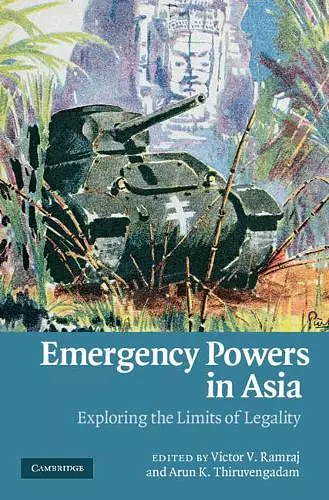Emergency Powers in Asia
Exploring the Limits of Legality
Victor V Ramraj editor Arun K Thiruvengadam editor
Format:Hardback
Publisher:Cambridge University Press
Published:10th Dec '09
Currently unavailable, and unfortunately no date known when it will be back

What role does, and should, legal, political, and constitutional norms play in constraining emergency powers, in Asia and beyond.
This collection of essays explores law's ability to constrain the invocation and use of emergency powers in times of crisis. It examines the nature and viability of constitutionalism in Asia and raises fundamental questions about the modern state, questions that invite legal, political, sociological and historical analysis.What is the relevance of contemporary debates over emergency powers for countries situated in Asia? What role does, and should, the constitution play in constraining these powers? The essays in this collection address these issues, drawing on emergency situations in over 20 countries in Asia as a ready-made laboratory for exploring the relationship between emergency powers and constitutionalism. This volume therefore rests squarely at the intersection of two debates – a debate over the ability of law to constrain the invocation and use of emergency powers by the executive in times of crisis, and a debate over the nature and viability of constitutionalism in Asia. At this intersection are fundamental questions about constitutionalism and the nature of the modern state, questions that invite legal, political, sociological and historical analysis.
'While emergency powers are most frequently resorted to in Asia, there is little systematic or comprehensive study of this phenomenon. Emergency powers can be a threat to liberal constitutionalism; it may also be a measure to restore stability and constitutional order. It may be an instrument of suppression, and yet in some circumstances, it may also serve to galvanize public support against authoritarian regimes. The role of emergency powers in liberal constitutional democracies, through which emergency powers are conventionally analyzed, is very different from that in developing countries, particularly in the transition from colonial rule to independence, or from political turbulence to relative tranquility. Can emergency powers be contained by the constitution, and more fundamentally, can constitutionalism be sustained and evolved alongside real, exaggerated or perceived emergency situations with a relatively fragile judiciary in many Asian states? This book provides a fresh perspective in understanding emergency powers by putting them squarely in the post-colonial and post-conflict social, legal, political and comparative context in Asia, thereby enabling an intellectual and theoretical engagement of the contemporary debates on this complex yet fascinating subject.' Johannes Chan S. C., University of Hong Kong
'Drawing on impressive presentations of factual material and offering provocative theoretical insights, the essays here make an important contribution to our understanding of the constitutional regulation of emergency powers, one of the central questions in constitutional law and theory in today's world.' Mark Tushnet, Harvard Law School
'The role of emergency provisions in the constitutional order has generated a good deal of attention recently, but too often, the analysis is either abstract or focused on a single jurisdiction. Ramraj and Thiruvengadam have produced a wonderful comparative collection on the use and misuse of emergency powers in Asia. With its wide range of political regimes, constitutional traditions, and security challenges, Asia offers a fruitful environment to examine how policy makers and judges have grappled with emergencies, both real and imagined. Theoretically informed, empirically rich and conceptually nuanced, this volume is a major contribution to the ongoing debates on constitutionalism and security, and should be read throughout the region and beyond.' Tom Ginsburg, University of Chicago Law School
ISBN: 9780521768900
Dimensions: 234mm x 158mm x 30mm
Weight: 960g
530 pages